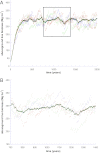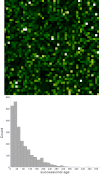The steady-state mosaic of disturbance and succession across an old-growth Central Amazon forest landscape
- PMID: 23359707
- PMCID: PMC3593828
- DOI: 10.1073/pnas.1202894110
The steady-state mosaic of disturbance and succession across an old-growth Central Amazon forest landscape
Abstract
Old-growth forest ecosystems comprise a mosaic of patches in different successional stages, with the fraction of the landscape in any particular state relatively constant over large temporal and spatial scales. The size distribution and return frequency of disturbance events, and subsequent recovery processes, determine to a large extent the spatial scale over which this old-growth steady state develops. Here, we characterize this mosaic for a Central Amazon forest by integrating field plot data, remote sensing disturbance probability distribution functions, and individual-based simulation modeling. Results demonstrate that a steady state of patches of varying successional age occurs over a relatively large spatial scale, with important implications for detecting temporal trends on plots that sample a small fraction of the landscape. Long highly significant stochastic runs averaging 1.0 Mg biomass⋅ha(-1)⋅y(-1) were often punctuated by episodic disturbance events, resulting in a sawtooth time series of hectare-scale tree biomass. To maximize the detection of temporal trends for this Central Amazon site (e.g., driven by CO2 fertilization), plots larger than 10 ha would provide the greatest sensitivity. A model-based analysis of fractional mortality across all gap sizes demonstrated that 9.1-16.9% of tree mortality was missing from plot-based approaches, underscoring the need to combine plot and remote-sensing methods for estimating net landscape carbon balance. Old-growth tropical forests can exhibit complex large-scale structure driven by disturbance and recovery cycles, with ecosystem and community attributes of hectare-scale plots exhibiting continuous dynamic departures from a steady-state condition.
Conflict of interest statement
The authors declare no conflict of interest.
Figures




Comment in
-
Geography of forest disturbance.Proc Natl Acad Sci U S A. 2013 Mar 5;110(10):3711-2. doi: 10.1073/pnas.1300396110. Epub 2013 Feb 20. Proc Natl Acad Sci U S A. 2013. PMID: 23426623 Free PMC article. No abstract available.
References
-
- Muller-Landau HC. Carbon cycle: Sink in the African jungle. Nature. 2009;457(7232):969–970. - PubMed
-
- Laurance WF, et al. Pervasive alteration of tree communities in undisturbed Amazonian forests. Nature. 2004;428(6979):171–175. - PubMed
-
- Phillips OL, et al. Increasing dominance of large lianas in Amazonian forests. Nature. 2002;418(6899):770–774. - PubMed
Publication types
MeSH terms
LinkOut - more resources
Full Text Sources
Other Literature Sources
Miscellaneous

